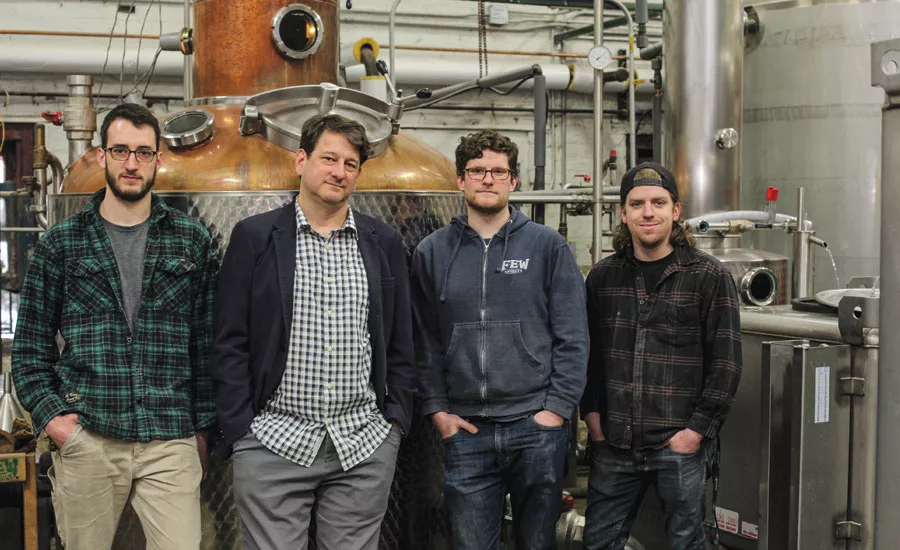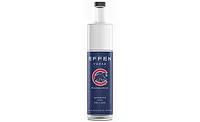FEW Spirits encourages creativity in craft spirits
Craft distiller innovates in the whiskey, gin categories

The beverage industry is one of constant change and evolution. As more consumers shift their focus toward local, handmade, high-quality beverages, the spirits market is not immune to the demand. As such, the craft spirits segment has made significant strides within the past several years. In fact, according to the Louisville, Ky.-based American Craft Spirits Association’s October 2017 Annual Craft Spirits Economic Briefing, U.S. craft spirits volume grew at an annual rate of 18.5 percent, reaching 5.8 million cases, and sales grew at an annual rate of 25 percent to $3 billion in 2016.
Among the players driving this growing market and making an impact on the overall distilling industry is Evanston, Ill.-based FEW Spirits LLC. Breaking down barriers to become the first alcohol producer in Evanston, a Chicagoland suburb known to many as the birthplace of the Temperance Movement, FEW Spirits has been making its presence known since its founding in 2011.
With a mission to create high-quality whiskey, Paul Hletko, founder and master distiller, started FEW Spirits as a one-man operation, handling product development, production, sales and every other aspect involved in the business. Since then, FEW Spirits has gained distribution in more than 40 states and about 30 countries around the world.
“The company just grows. When we started up, I was alone in the room. It was literally just me doing everything. Now, we’ve grown, [and] we’ve got 16 people. We hit our 10-year sales goals in our third year. We’ve been lucky we’ve been able to grow pretty quickly. We’ve worked pretty hard, too,” Hletko says. “The company is really growing and it’s natural growth. I don’t really see it too much as being a forced growth. Until we actually started really growing, there wasn’t any money to spend to grow, so it was all organic. I was the only sales person for the world, [but] now we’ve got more.”
But as the company has grown, its aspirations to make the best whiskey in the world have never changed.
“I think our goal remains the same. Our goal is to make the best whiskey in the world, and that’s what we really strive to do every day. What can we do better? How can we make it better? How can we make better whiskey? How can we be more consistent? What can we do to improve every single day? And I think that’s the goal,” Hletko says. “Obviously, there’s business goals where you want to grow and you’ve got sales numbers to hit. As we’ve grown, some of that infrastructure starts to build up the way these things tend to happen in the business world, but we’ve really tried to stay in sight of our goal — we’re driven to make the best whiskey in the world. I don’t know if we’ll ever get there. What is the best whiskey in the world? But that’s the goal.”
Founded in a repurposed automotive repair shop hidden away in an alley off of Chicago Avenue in Evanston, FEW Spirits’ taproom and distillery remain in the original building where the company began. However, as sales increased, FEW outgrew the small location and thus acquired two additional buildings — one of them less than a year ago — which have helped to accommodate barrel storage and bottling.
“We’ve got three buildings. Our farthest one is 1.4 miles away. It’s close, [but] it’s like a 15-minute drive because of traffic — it is Chicago,” Hletko explains. “It’s a logistical challenge, and one of the reasons we’re really happy about this new facility is that it’s much larger, and so we’ll be able to have more people under one roof. We’ll primarily have barrel storage in a couple of different places, while the actual people are working at one, and reduce that logistical challenge. Right now, we have a pick-up truck, and it just runs barrels back and forth … and it just circles around — bring empty barrels here, fill them up [and] move the barrels there. It’s hard and time-consuming, and we’re hoping to reduce that in the future.”
The new building is scheduled to be expanded within the next year or two to help increase FEW’s production capacity, Hletko says.
Although the company is deliberately slowing its growth, expansion will continue, Hletko explains. However, he notes that the FEW Spirits team is the reason that the company has become successful and remain a strong player in the craft spirits market.
“We’re not quite national yet … we’re missing Ohio, we’re missing Maine, [and] a couple other states that we don’t have distribution in quite yet, but this time next year, I think we’ll be [in] 50 states,” Hletko says. “It’s really exciting, and it’s fun to be part of a team that can do stuff like this. It’s not about me, it’s really a team effort. Obviously, I’m part of the team, but from the guys that run the stills, the guys who run the rackhouse, and the guys who are doing the barreling and bottling, we have a hell of a team of passionate and dedicated people who make it happen. That’s the really exciting part is seeing what we all do together.”
Fun, quality portfolio
Although FEW has a strong focus on its whiskey products, the company’s first commercially available product was its American Gin.
“The first product we made available was our American Gin, which is kind of a very light, modern-style gin, [with] lots of citrus and vanilla — a very light and approachable gin,” Hletko explains. “We started off producing whiskey, but of course that went into barrel and was sitting down there for some time while we were selling out gin.”
Since then, the core portfolio has grown to include three whiskeys and three gins. FEW’s Bourbon Whiskey and Rye Whiskey are its No. 1 and No. 2 selling products, respectively. Breakfast Gin rounds out the Top 3, Hletko says. Although all of its products are unique, they share a similar sense of innovation and style, he notes.
“I think all of our whiskeys share what we refer to as its own ‘FEW-ness,’ and I think you can identify a product from us pretty quickly if you know who and what we are. Once you’ve tried a couple of our [products], you can pick out, ‘oh, that’s a FEW product,’” Hletko says. “But, we’ve never been good about identifying exactly what that ‘FEW-ness’ is or what it means. Our bourbon is differentiated by using a different yeast for the fermentation, so our bourbon is extremely spicy. Our rye mash bill is relatively unique, and we use a wine yeast to ferment the rye, very unique. So instead of just having a rye whiskey be a total spice bomb, we’ve got a … little note of sweetness and some fruitiness, [which is] very unique in the rye whiskey space.”
FEW’s gins also benefit from the distillery’s passion for innovation and the common ‘FEW-ness’ of its products.
“We try to do something different. You cannot compete with London dry gin by making another London dry gin. You have to do something that’s new and different, and that’s where I think we really strive, and again, trying to be creative and do something new,” Hletko says. “[For example,] things like the Breakfast Gin with Earl Grey tea, [and] we didn’t invent barrel-aged gin by any stretch of the imagination, but we were pretty early in doing it. … Our gins tend to be based on a whiskey base as well. Instead of having it be just juniper-flavored vodka, it’s going to have a little bit more texture, it’s going to have a little bit more sweetness.
“…I think that’s where we try to stand out is by having a different and alternate take on what gin can be. It’s not just kissing a Christmas tree, it’s a subtle beverage,” he adds.
Regardless of the spirit, every bottle of FEW is handcrafted at the Evanston distillery from grain to glass. From when the grains arrive at the distillery to barreling and bottling, all of the work is done by hand, Hletko says. The spirits also are made from the best quality ingredients, which are fermented in a controlled fashion, he adds.
“That’s all done by hand. We are small, and yes, we’re on the bigger side than when we started, but we’re small,” he says.
Although the quality and creativity of the spirit within keeps bringing consumers back to FEW Spirits’ products, the packaging is essential for drawing them in and telling FEW’s story, Hletko notes. FEW Spirits are packaged in 750-ml, rectangle-shaped glass bottles, which feature imagery from the 1893 Chicago World’s Fair.
With vibrant colors on a white background, the packaging offers a break from the slew of brown-colored packaging in the whiskey aisle, Hletko says. In addition to the Chicago World’s Fair imagery, the side label is designed to mimic a ticket to the Chicago World’s Fair, inviting consumers to get their ticket to the fun, he adds.
“All of our label iconography is based on the Columbian Expedition in 1893. The world’s first Ferris wheel, the Statue of the Republic, the first electric water fountain. Evanston resident and Women’s Christian Temperance Union President Frances Willard was the featured speaker, speaking on this concept of temperance and prohibition at the World’s Fair,” Hletko explains. “[Our labels] tell the story of where and who we are and gives us that time and place that I think is the cornerstone. … We stand for the rebirth of a golden age of Chicago.
“… Chicago had burned to the ground in the Great Chicago Fire in the 1870s, and the World’s Fair crystalized Chicago as a rebuilt major metropolitan area for the world,” he continues. “It’s a rebirth of the best that humanity has to offer in the form of the white city sprung up out of ashes. That’s the kind of story I want to tell. FEW is the rebirth of spirits in the birthplace of prohibition. We want to be a rebirth of creativity in a spirits business that had gotten a little stagnated. We want to be the rebirth of the best that can be offered. It’s a little grandiose and a little bit egotistical, but you have to strive for something and make no small plans.”
Spirit of innovation
To help drive its innovation and encourage experimentation, FEW Spirits requires that all of its employees create their own product, which is how Breakfast Gin spawned, Hletko says. Breakfast Gin is made with Earl Grey tea and features a subtle herbal character with some astringency and a complementing bergamot character, he adds.
“We set up to create and make new stuff, and then some of that stuff works really well, and part of the joy of innovation is that some of your innovation doesn’t work as well. … Breakfast Gin is a perfect example. It was launched as a joke. I thought it was really funny, and we launched it as a distillery-only release because I thought ‘this is great, this is funny.’ But the gin isn’t a joke, it’s not a gimmicky gin in the slightest,” Hletko says. “It’s a truly spectacular gin with a great name. And [when] we launched it, we had our fun, but then our distributors started calling us up [and asking] ‘How come you’ve got this Breakfast Gin and you won’t sell it to us? Why am I hearing about this?’ The press was calling us up, ‘You’ve got a Breakfast Gin? I need to know more.’ … So with stuff like that, you’re like ‘Well you know, maybe this is a lot less funny than I thought it was. Maybe I should listen to this.’
“… You have an idea, and you try it. And all of us here do it as well. It’s not just me. The FEW story is not just the Paul story, this is a family effort, and we actually have a rule that if you’re working here, you have to create something,” he continues. “You have to come up with a recipe idea [and] you have to try it. We try to make sure the judging of what we experiment with is not related at all to how commercial it is. We try to judge based on how fun it is.”
With the encouraged creativity, FEW Spirits often releases limited-edition products. However, innovation isn’t just in-house. FEW also collaborates with others to create new products.
A creative-minded person himself, Hletko is inspired by working with other innovators. As such, FEW Spirits has collaborated with a variety of other groups and businesses. For instance, FEW collaborated with Folio Wine Partners and Eataly Chicago to create a Sicilian wine barrel-finished bourbon. It also has worked with Copper & Kings and Philadelphia Distilling, among others, and even with the rock band The Flaming Lips.
“We do a lot of collaboration because it’s fun,” Hletko says. “It’s that creative process and working with other creative people and doing stuff you wouldn’t necessarily always do otherwise. Everybody has their own creative spark in them, and working with other people to get that, it’s great.”
FEW also has collaborated internationally, most notably to create a Brexit Gin in the United Kingdom.
“We did a Brexit Gin with our friends in the U.K., where there were five botanicals in the mix, and four of them got together and voted one of the botanicals out. Then, we increased the lime content very dramatically, so that for this one batch of gin we were the country’s largest purchaser of this one type of lime product for the year,” Hletko explains. “… Again that passion to drive and create and make new stuff, I don’t ever want to lose that.”
It’s this spirit of innovation and quality that brings consumers back to its products and differentiates FEW, Hletko says.
“I think [consumers] choose us for two reasons. One of them is going to be quality. You could never beat the quality of the major suppliers, but you can certainly be on par, and I think we’re on par with the major suppliers. I think our consumers are looking for that beacon of quality and have come to know and trust that FEW is the standard of craft spirits quality,” he explains. “Two, I think they’ve come to know and identify us as being one of the more creative distilleries out there. We are making new and different things constantly and doing it, not to boast, but I think we do it really well. We’re always creating new things and expanding the category — expanding what craft spirits can be. I think the marketplace looks to FEW for quality as well as innovation and creativity.” BI
Looking for a reprint of this article?
From high-res PDFs to custom plaques, order your copy today!








